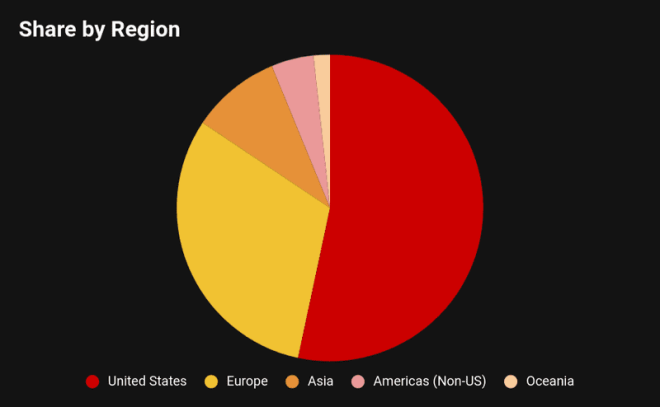From OSHData:
Special Report | State of Open Hardware in Europe
Introduction
OSHdata findings show that the Open Source Hardware (OSH) community is dynamic, growing, and still in its early days as a formal movement. For context, know that this report relies on the Open Source Hardware definition and the Open Source Hardware certification program, as defined by the Open Source Hardware Association. Learn more by visiting: https://oshwa.org/
As of February 2020, there are over 400 certified projects from 36 countries spanning five continents. The certification rate is increasing, too. Getting from 200 to 300 certified projects took nearly a year, but getting from 300 to 400 took a little over six months. Nearly 60% of the certified projects are available for sale at an average sale price of $211.47, though there is a big range here. The leading project categories include: electronics, 3D printing, tools, and education.
Comparative Output
If the European Union were a country, it would be second only to the United States in terms of the number of certified projects. European companies and creators have certified 125 different projects, versus 215 in the United States. Combined, they represent 85% of all certified projects worldwide.
Introduction
OSHdata findings show that the Open Source Hardware (OSH) community is dynamic, growing, and still in its early days as a formal movement. For context, know that this report relies on the Open Source Hardware definition and the Open Source Hardware certification program, as defined by the Open Source Hardware Association. Learn more by visiting: https://oshwa.org/
As of February 2020, there are over 400 certified projects from 36 countries spanning five continents. The certification rate is increasing, too. Getting from 200 to 300 certified projects took nearly a year, but getting from 300 to 400 took a little over six months. Nearly 60% of the certified projects are available for sale at an average sale price of $211.47, though there is a big range here. The leading project categories include: electronics, 3D printing, tools, and education.
Comparative Output
If the European Union were a country, it would be second only to the United States in terms of the number of certified projects. European companies and creators have certified 125 different projects, versus 215 in the United States. Combined, they represent 85% of all certified projects worldwide.
See a dynamic and interactive visualization of these trends — showing country leadership by month dating back to 2016 — by visiting: https://public.flourish.studio/visualisation/1838881/
Quality of Work
It is important to note that the earlier measures merely focus on quantity, not quality. Select projects represent an evolutionary step forward because of the complex and “full stack” nature of the projects themselves. A simple 3D model can be considered an Open Source Hardware design, but there is a categorical difference between a widget and electronics that can function in outer space.
European companies and creators are contributing across a breadth of fields from high end cameras (like the AXIOM in Austria) and satellite equipment (like SatNOGS in Greece). They are also creating the enabling technologies that sup
See a dynamic and interactive visualization of these trends — showing country leadership by month dating back to 2016 — by visiting: https://public.flourish.studio/visualisation/1838881/
Quality of Work
It is important to note that the earlier measures merely focus on quantity, not quality. Select projects represent an evolutionary step forward because of the complex and “full stack” nature of the projects themselves. A simple 3D model can be considered an Open Source Hardware design, but there is a categorical difference between a widget and electronics that can function in outer space.
European companies and creators are contributing across a breadth of fields from high end cameras (like the AXIOM in Austria) and satellite equipment (like SatNOGS in Greece). They are also creating the enabling technologies that support industrial capability (e.g. sensors, breakout boards, and Internet-connected devices).
Broad Participation
Participation spans the continent. While technology and manufacturing leaders like Germany and France are well represented, the Open Source Hardware capital of Europe is Plovdiv, Bulgaria thanks to the outsized contributions from companies like Olimex and ANAVI Technology. Other participating countries include: Greece, Sweden, Croatia, Netherlands, Poland, Slovakia, Austria, Belgium, and Norway.
Top Countries Total Bulgaria 59 Germany 14 France 8 Spain 7 Switzerland 7 United Kingdom 7

